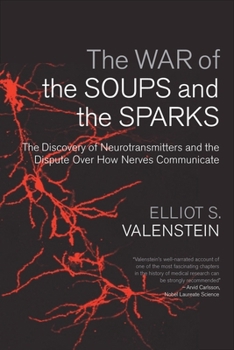The War of the Soups and the Sparks: The Discovery of Neurotransmitters and the Dispute Over How Nerves Communicate
Select Format
Select Condition 
Book Overview
Like the cracking of the genetic code and the creation of the atomic bomb, the discovery of how the brain's neurons work is one of the fundamental scientific developments of the twentieth century. The... This description may be from another edition of this product.
Format:Hardcover
Language:English
ISBN:0231135882
ISBN13:9780231135887
Release Date:July 2005
Publisher:Columbia University Press
Length:256 Pages
Weight:0.97 lbs.
Dimensions:1.0" x 6.4" x 9.6"
Grade Range:Postsecondary and higher
Customer Reviews
3 ratings
Education and entertainment: a wonderful book!
Published by Thriftbooks.com User , 15 years ago
Valenstein's War of the Soups and the Sparks is a terrific combination of the science and the human story of the revolution in neuroscience that led us to an understanding of the role of chemical neurotransmission. I used it as a text and a discussion-starter in a graduate course in neuroscience and it succeeded admirably. Not only did it provide basic information on the basics of catecholaminergic and cholinergic transmitters but it provided historical background and considerable insight into scientific ethics, the historical context in which we work as neuroscientists, and the human story behind scientific progress.
Nice beach book!
Published by Thriftbooks.com User , 15 years ago
This book was reviewed in Nature a few years back and the topic sounded interesting so I bought it. The book tells the story of how the question of whether neurons (the cells in your brain and nerves) communicate with each other via electrical impulses or instead use chemical transmitters was answered. It is a very smooth reading with interesting characters and interesting science. I think in order to fully appreciate the story you need some basic biomedical background, but not much. I am no pharmacologist and I still found the book very entertaining, so much so, that I couldn't put it down and finished it over a couple of days at the beach. I know now what the electrophysiology folks are part of the pharmacology department and not vice versa!
A great and important story with incredible characters
Published by Thriftbooks.com User , 17 years ago
In this immensely readable book, Elliot Valenstein provides a remarkable account of one of the great scientific discoveries of the 20th century. The discovery of how nerve cells communicate has revolutionized our understanding of the brain. The story behind this momentous discovery is a fascinating one and it includes the joint effort of many remarkable men. The road to the discovery of neurotransmitters involved the work of many different scientists but three individuals in particular are of vital importance to this story: Henry Dale, Otto Loewi (both pharmacologists) and the great American physiologist, Walter Cannon. The initial insights that nerve communication could be chemically mediated stemmed from the research findings that specific chemical compounds (at that time, these compounds were derived mainly from plant extracts and laboratory synthesis) could mimic the effects of sympathetic and parasympathetic nerve innervation. Since it was not known at the time that the chemical compounds in question (such as acetylcholine, epinephrine and norepinephrine) were substances naturally found in the body, nobody had yet speculated that the nerves were actually secreting these mediators. One of the seminal experiments (the inspiration for which apparently originated from a dream) was that of Otto Loewi. Loewi performed a simple experiment on isolated frog hearts - he showed that stimulating the vagus nerve of the first heart led to a substantial decrease of the heart rhythm. Loewi then collected the chemical perfusion collected from this heart and applied it to the second heart (without stimulating the vagus nerve). Remarkably, the mere application of the chemical substance led to a substantial decrease in heart rate. However, far from proving the existence of neurotransmitters, controversy continued to rage at least for another decade. Later, Henry Dale, with the help of Wilhelm Feldberg, had shown that this chemical substance was acetylcholine and moreover that all parasympathetic nerves released this neurotransmitter. At the same time, Walter Cannon was doing work on the sympathetic nervous system and the role of epinephrine and norepinephrine. Dale and Loewi shared the Nobel prize in 1936 for proving that neurotransmitters are involved in the action of the autonomic nervous system on smooth muscles. Walter Cannon came extremely close to sharing the prize - the reason for his ultimate exclusion is just one of the book's interesting stories. Even after the role of neurotransmitters was accepted for the autonomic nervous system, there was incredible resistance toward extending these findings to the central nervous system. This resistance was in part due to a professional turf war between the pharmacologists and neurophysiologists. The neurophysiologists refused to accept that nerve transmission in the central nervous system could be chemical, reasoning that this was too slow a process. Instead, they maintained that central nervous system synaps





